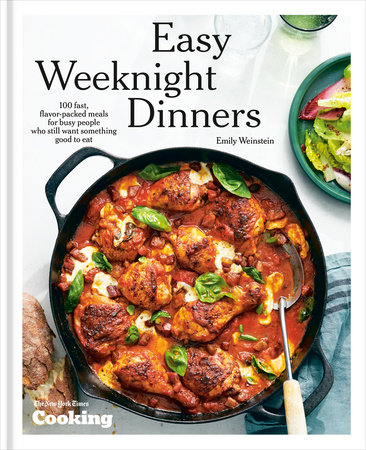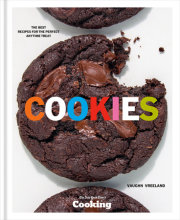IntroductionIt’s 4 p.m., and I’m thinking about dinner.
Will it be chicken? Tofu? Pasta? Should I defrost the salmon? What about those black beans in the fridge? Are there vegetables to use up? What do I have? What do I want? How much energy am I willing to spend on this tonight? Should we just get takeout?
You can be as passionate about food as I am—food and the act of cooking it are central to my daily life—and still find yourself spinning out over dinner and the immediate yet eternal question of what to cook. Dinner, again, and again, and again, and it has to be something you can get on the table quickly and that everyone will eat. And in a perfect world, it also tastes great. Even if you love to cook, which not everyone does, this dinner situation gets to be a lot.
That’s why we’ve created this cookbook. It’s for busy people—like you—who still want something good to eat but don’t know where to start or what to make. This collection of 100 recipes will not only solve the dinner problem, but will inspire you with ideas and lead you somewhere delicious—even when you don’t have much time.
I love recipes, and I put a lot of faith in them. I love the possibility of them, imagining the flavors, textures and varying bites. I also love the fact that a good recipe is a map to deliciousness: follow it, step-by-step, and you’ll arrive at your destination.
Because of my job—I’m the editor in chief of Cooking and Food at
The New York Times—people sometimes assume I’m a chef or went to culinary school. Nope! I don’t have any formal culinary training, and while I grew up well fed with endless helpings of chicken cutlets, spaghetti and boxed macaroni and cheese, I didn’t learn to cook at home as a kid. I learned to cook as an adult, from excellent recipes and early failures.
Oh, the failures. I had no sense of how to chop or season ingredients. I was sloppy. I burned things. I’d invite friends over to keep me company and share the food, but I couldn’t time anything right and often served dinner way after 10 p.m., even though I’d told them 8. My small apartment kitchen was a mess; once in such a state of chaos that when a stove burner flared up, it set fire to a stack of oil-spattered recipes on the counter, and then a vase of dried hydrangeas nearby. I had to run to the bathroom, throw the flowers in the tub and yank on the cold water to put out the fire.
But I also remember some amazing moments in those early days, meals I was shocked that I actually made myself. There was a roast chicken dinner where I sat down at the table and felt things had started to click: the chicken was bronzed and juicy, the carrots sweet and tender. I cooked and cooked, leisurely picking up ingredients on the way home from work based on what I was in the mood to make. On weekends, I’d often disappear into the kitchen for entire days to make huge dinners for parties.
At the same time, cooking had become more central to my work life. By then, I’d worked at
The New York Times for a few years, and I’d started editing recipes, which taught me about how the best ones are written (clear and to the point, not too long, with enough visual cues to help cooks know when the food is done). I also learned what good ideas look and taste like.
I got married. I had a baby, and then another. I kept cooking, though now, of course, it was different because I—a person with a full-time job, a partner and two kids—needed those recipes to be as fast and simple as possible. Gone were the evenings when I stopped at the market to buy mussels to cook on a whim; now I planned, plotting out meals and getting groceries on Sunday for the week ahead.
Personally and professionally, this was the moment I started to zero in on quick, easy dishes, recipes that were delicious but also doable. This is the food I needed, and I knew others needed, too, no matter where they were in life, whether younger or older; single or partnered; living with children at home, or past that stage, or never planning to enter it at all. It doesn’t matter how much you love to cook. Sometimes you just don’t want to spend hours in the kitchen prepping, cooking and cleaning. (My husband did and still does all the cleaning up, an arrangement I highly recommend if you have a partner, love to cook and hate to clean.)
I began writing a newsletter with dinner recipes, Five Weeknight Dishes and, with my coworkers, publishing the recipes that fill the book that you’re holding in your hands.
Every one of these recipes can be made in under an hour, and many of them in less than 30 minutes. They’re genuinely quick, and if they take a bit longer, the work is hands-off: you slide a pan into the oven, set a timer and walk away. They don’t require more than two pots or pans, and they don’t call for special equipment beyond a blender, just to make cleanup a little easier.
Sometimes simple recipes can be dull or dutiful, and they can be boring to eat day after day. Not these recipes. These recipes are inspired. They pop. They use electrifying ingredients (gochujang, chile crisp, Tajín!), clever techniques and brilliant shortcuts.
They’re rooted in cultures around the world, but they’ve been remixed into something wholly new. They make it easy to cook and exciting to eat, and that’s true whether it’s a Tuesday or a Saturday (because really, weeknight recipes taste just as good on the weekends).
Many of the recipes in this book are the ones I have on repeat in my own kitchen. The revelation that feta is delicious baked in a hot oven has changed my weeknights, with recipes like Ali Slagle’s sheet-pan feta with chickpeas and tomatoes (page 247) in heavy rotation. Kay Chun’s pork meatballs with ginger and fish sauce (page 170) are as genius as she is; I eat them over rice, piled with fresh herbs. Melissa Clark’s fast garlicky chicken with lemon-anchovy sauce (page 33) was the recipe that awakened me to the necessity of anchovies. Tejal Rao’s eggs Kejriwal (page 229) are a favorite, especially because I almost always have the ingredients on hand (eggs, Dijon mustard, jalapeños, toast), and they add up to something much bolder than the sum of their parts. Eric Kim’s gyeran bap (page 230)—rice with a buttery soy sauce–fried egg on top—has revolutionized both lunch and dinner in my kitchen. And throughout this book, you’ll see comments from real cooks in the NYT Cooking community, endorsing their favorite recipes. (I’ve created a recipe index for you on pages 12 to 15 to help you find your way to the recipes you want as quickly as possible.)
I’ve always described my newsletter as being for busy people who still want something good to eat. That’s me, and my friends and family, and I’m guessing you, too. It’s hard to throw cooking into the whirring cycles of daily life. I hope these recipes make it a little easier, and life more delicious. After all these years of cooking and building confidence in the kitchen, I still love recipes, and I keep coming back to them. I hope you do, too.
Copyright © 2024 by Emily Weinstein and The New York Times Cooking. All rights reserved. No part of this excerpt may be reproduced or reprinted without permission in writing from the publisher.

















